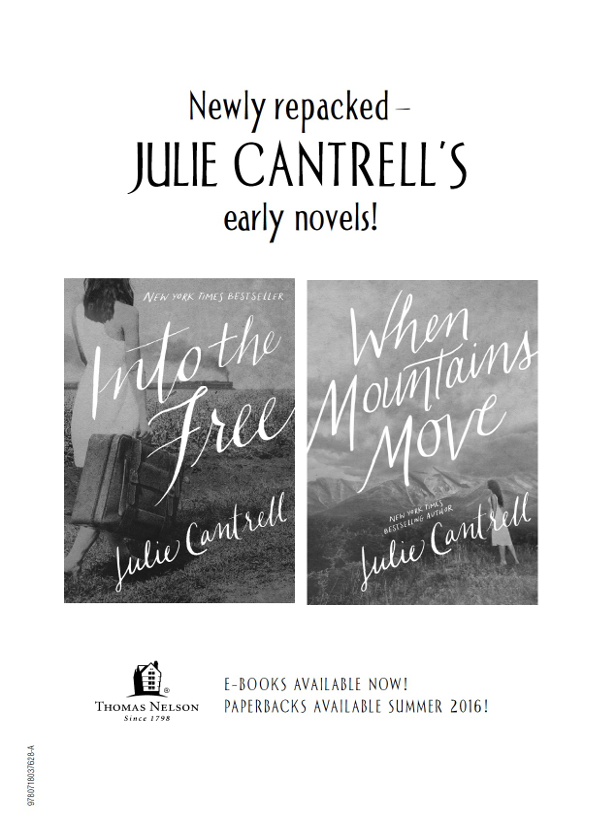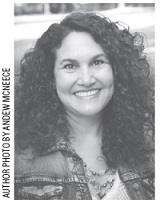The Feathered Bone (48 page)
Read The Feathered Bone Online
Authors: Julie Cantrell

Jay looks to me and says, “Just think . . . if she hadn't had the guts to step out of that mess.”

At seven o'clock sharp, a fleet of boats let loose their hollow horns. More than one hundred fires are lit.
“You know why we do this?” The flames fly high as Preacher explains. “So Santa can find his way in the dark.”
Raelynn's youngest laughs, not quite believing anymore. But Kayla perks up at the mention of Santa.
Jay takes my hand in his. Smoke drifts over the water, and the bright line of fire reflects orange across the ribboned river.
Maybe Jay and Sarah are onto something. Maybe I have spent
the last few years building a levee around my heart. So determined to protect myself from harm, I stayed frozen in a terrible place. But sometimes life brings a storm strong enough to break through the highest flood walls. Only after the clouds have cleared do we know we've survived.
Now this storm is over. And here we are, still standing. We have climbed to the top of this levee where bonfires blaze across the ridgeline. The pyres shine far and wideâso that love can come and find us, even in the dark.
As the embers rise, locals break out their guitars, accordions, washboards, and fiddles. We clap and sing along to the familiar tune “Would You Fly.” Within the first few measures, hundreds are lifting their voices into the night.
In the warmth of these bonfires, silhouetted in their towering light, I am surrounded by those I love most in this world. The darkness is being kept at bay. And the music plays.
And the music plays.
W
RITERS ARE FREQUENTLY ASKED
, “W
HERE DO YOU COME UP
with your ideas?” While this particular story is a work of fiction, many things came together to inspire Amanda's tale.
First, the loss of my own brother to suicide when he was a senior in high school. I write this in memory of Jeff, whose light still shines. My brother was loved, and he lived a life of love. He is greatly missed. Every second. Every day.
Second, I have seen too many friends endure the tragic death of a child. I have mourned their loss and observed the struggle they face while navigating this horrific trauma. To each of you who has known this unbearable grief, my heart hurts for you, and I thank you for showing us such models of strength and courage.
Third, I was mesmerized by the story of Elizabeth Smart and her personal account of miracles and faith that kept her spiritually strong in the face of evil. Elizabeth, you inspire me and countless others. This story exists because of you.
Fourth, I am passionate about being the voice for the many women (and men) who endure emotional and/or physical abuse for the sake of keeping a marriage/family together, or because they are too afraid/too in danger to escape safely, or because this abuse is all they know of love, or because this is what they believe they deserve.
To you, I ask, what good is it to have feathers if you don't fly? You are worthy of being loved. You are worthy of being free.
Fifth, I long to reach the many teens who suffer from depression or despair and who feel misunderstood and hopeless in this great big world. To you, I promise, it will get better! Inhale. Exhale. Good things await. Please don't let the pain win. You are stronger than you think you are.
Sixth, I saw a 2006 documentary film,
The Bridge
, which was written by Tad Friend and directed by Eric Steel. This film explores Golden Gate bridge suicides and led to my alternative telling in this book about a suicidal man in front of Walmart who wanted one person to smile at him. I want to be the person who smiles. I encourage you to be that person too.
Seventh, I was at a low point in my own life when I saw a viral video that had been posted on December 12, 2013, by Hope for Paws. This emotional clip featured the story of a dog who was rescued from a terrible life in a trash pile and inspired the final scene of this book, during which Sarah compares the dog's experience to her own. I send a heartfelt thank-you to all of you who reach out a helping hand and who understand the fear that keeps a hurting soul in a place of pain.
Eighth, I've had the honor of meeting with many people who have been abused and/or trafficked in America. These survivors bravely opened their hearts to me and told me their truths. These are people you work with, study with, live near, worship with. People you would never know had endured such unjust cruelties in their lives. They are strong, and many of them believe they only managed to survive because of their faith in God. Whether or not you consider yourself a spiritual person, it is hard to deny someone who stands in front of you and says, “God was with me,” when
describing one of the most vile scenarios humanly imaginable. There is power in that kind of faith, and that's what I hope to have brought to the pages of this story.
All of these experiences combined to form a novel about the many forms of slavery and all the ways our souls can become trapped in dark places.
The Feathered Bone
is written for every person who has ever felt alone, unloved, unsafe, or unvalued. It is written to remind us all that we are loved, we have worth, and we are never alone.
I
N
L
OUISIANA, THE BEST WAY TO MAKE GUMBO IS TO INVITE
others to add to the pot. Many people touched this story as it was simmering. Please visit my website, www.juliecantrell.com, where I share more about the wonderful people who contributed. I could not have built this fictional world without them.
Thanks to Nathan Deroche and Pat Hymel of Blind River Chapel as well as Martha and Bobby Deroche, Val Amato, Charlie and Jimmy Duhe, Moise Oubre, and Tommy Zeringue. To river friends: Pam Brignac, Barbara and Steven Gallo, Earl Hoseth, Michael Dale Howze, Damon Miley, Dennis Rohner, and Rhonda Littleton Sibley.
To Louisiana State Police Lieutenant Chad Gremillion, Sheriff Jason Ard, his lovely wife Erica, and the entire Livingston Parish Sheriff's Department. To Anny Donewald of Eve's Angels; Prof. Richard Campanella, with the Tulane School of Architecture; and Dr. J. V. Remsen, with the LSU Museum of Natural Science.
To LP'ers Anjel and Stan Cain, Dean Coates, Tammy Palmer Crawford, Nicole and Mike Green, Stephen Paul Howze, Kay Palmer, the entire Aydell Family and the Walker Museum, Myra Streeter, and everyone who ever brought me fishing, frogging, crawfishing, skiing, boating, hiking, exploring, or “to da camp.” To the
congregations of both Walker Baptist and Judson Baptist Church, especially to Betty Marsh. To the teachers of the Walker public schools, particularly Linda Purcell. To Carolyn and Sonny Aucoin, who made the wild woods my own. And to New Orleans friends: Christa Allan, Marci Glascock Lichtl, and Stephen Lukinovich.
To Taylor Bellard and my OGH gang: Paula, Pinky, Tammy, and Vickie. To Kenny, David, Craig, Stacy and Randy, Connie and Bobski, Gail, Mike and Cora, Josh, and Jessie. To Glenda and Jimmy Bell; Judy and Billy Kaufman; Mary and Mike Nola; Brenda Pepitone; the Livingston Parish Public Library and the East Baton Rouge Parish Regional Library;
The Livingston Parish News
;
The Advocate
; Rick Wentzel and the Livingston Parish School Board; Austin Flowers; Don's Seafood; Kay Landry and the Rotary Club of Livingston Parish; Blaine Kern's Mardi Gras World, St. Louis Cathedral, Algiers Point/Canal Street Ferry and Café du Monde; and the Baton Rouge Crisis Intervention Center. And to my Holy Yoga friends: Amber, Brigid, Catherine, Jane, Joy, Julie, Kaci, Kristi, Laura, Laurie, Lorraine, Lucinda, Mandy, Rachel, Stacy, Tiffany, Wendy, and NICOLEâmy soul sister.
To Texas friends: Ashely Tesar; Still Creek Ranch; and College Station's Busy Moms Bookclub, specifically Kelli Backstrom, Ginny Brown, Gay Craig, and Brenda Rogers.
To my agent, Greg Johnson. To my posse: Christa Allan, Kerri Greene, Carol Langendoen, Michael Morris, Larry Wells, and Lisa Wingate. And to Mary Ann Bowenâthe world needs more people like you. To Katie Bond, Amanda Bostic, Elizabeth Hudson, Jodi Hughes, Daisy Hutton, LB Norton, and everyone at TNZ Fiction.
Thanks to the best mom in the universe, Cindy Perkins. And to my husband, Charles, and our children, Emily and Adam,
whose spirits and spunk bring more joy, love, and laughter to my life than I could ever measure.
Finally, to every reader who gives this story a chance. I offer a great big heaping helping of gratitude for all of you. Merci beaucoup and bon appétit!
1. We begin the story with Amanda examining the movement of the river and the boats around her while describing herself as “landbound.” How does this represent her life?
2. In an early scene, Sarah and Ellie pull on costumes for photos, displaying childhood innocence. Consider the deeper meaning of “disguising” or “masking” our true selves. How does this play out when Sarah is kidnapped, in costume, and called by a different name? How does she manage to stay in tune with her authentic self and not forget her own truth?
3. Issues of faith are presented early in the book. We learn about the religious traditions of Mardi Gras and then see the cathedral spires rise above the fog as we ferry across the river. What do these initial images tell about the role faith plays in Louisiana culture? Examine the contrast of light vs. dark that is explored throughout the story.
4. While in New Orleans, Amanda notices a prostitute. She feels compassion for the young woman but believes things like kidnapping and trafficking don't happen to “people like us.” Discuss the factors that result in human trafficking and take time to learn about the impact on your local community. What
does it say about us as a people if we ignore the exploitation of human beings, especially children?
5. Hurricane Katrina is explored in
Part II
of this story. Examine the reasons people may have chosen to stay in the evacuation zone and weather the storm. Can similar constraints apply in situations such as trafficking, domestic violence, and abuse? Consider the parallels.
6. Amanda struggles with the childhood wound of abandonment. She has felt unloved her entire life, despite having been loved greatly by her mother, her daughter, and her friends. How might this wound have impacted her choice to marry Carl, the one person who did not love her in a healthy way? What does she learn to accept about herself? About her husband? Do you believe, as Amanda learns from Viv, that we marry to heal our childhood wounds?
7. Throughout the book, our characters each build defenses for various reasons. Some harden their hearts completely, too hurt to give or receive love anymore. Amanda has the choice to harden or to heal. In the end, she takes a chance and allows Jay to “breech the levee of her heart.” Is this the core meaning of faithâto remove those defensive barriers and return to an open heart? What does the Bible say about love? (1 Corinthians 13:4â7; 1 Corinthians 13:13; John 13:34; 1 John 4:7; 1 John 4:19)
8. Discuss the symbolism of the feathered bone, the role of women throughout history, and the idea of birds flying free vs. being caged. What do you want your daughters and granddaughters to know about being a woman? What do you want your sons and grandsons to know about how to treat women? What do our characters learn?


